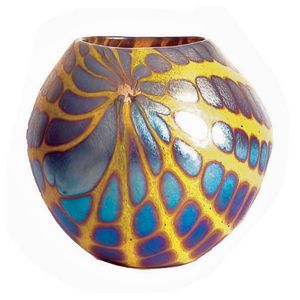Iridescent Butterfly Wing Vase by Norman Stuart-Clarke
You must be a subscriber, and be logged in to view price and dealer details.
Subscribe Now to view actual auction price for this item
When you subscribe, you have the option of setting the currency in which to display prices to $Au, $US, $NZ or Stg.
- Oviform /ovoid - The outline loosely resembling the shape of an egg.
- Irridescent Glass - Iridescent glass has a shimmering or rainbow-like appearance due to the way it reflects light. It is created by applying a thin layer of metal oxides to the surface of the glass while it is still hot and malleable, which then creates an interference effect that produces a range of colours as the light reflects off the surface. The exact colours and patterns created by iridescent glass depend on the specific types of metal oxides used and the techniques used to apply them.
Iridescent glass was first developed in the late 19th century, and quickly became popular for use in decorative art glass and stained glass windows. Some of the most famous examples of iridescent glass were created by artists such as Louis Comfort Tiffany and his studio, who used it extensively in their distinctive lamps, vases, and other decorative objects. - Incised - A record of a name, date or inscription, or a decoration scratched into a surface, usually of a glass or ceramic item with a blunt instrument to make a coarse indentation. Compare with engraving where the surface is cut with a sharp instrument such as a metal needle or rotating tool to achieve a fine indentation.
This item has been included into following indexes:
Visually similar items

Gouda Royal Goedewaagen vase of round form, having a glosed glaze with floral motifs, duck egg blue interior & marked to the base 'Kers Royal Goedewaagen Gouda Made in Holland'. Condition good, minor wear to the base. Height 15 cm

Arthur Merric Boyd (1862-1940) & John Perceval (1923-2000), an earthenware bowl, hand painted interior depicting mythological creatures, 26 cm diameter. Provenance: Joshua McClelland gallery

Chinese blue and white ceramic bowl, decorated with figures in a mountain landscape. Height 14 cm, diameter 27 cm

Chinese Wucai porcelain box and cover, of bun form, decorated with dragons and phoenix among floral scrolls, six character mark within double ring to base, diameter 25 cm
